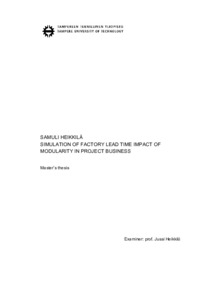Simulation of factory lead time impact of modularity in project business
Heikkilä, Samuli (2018)
Heikkilä, Samuli
2018
Tuotantotalous
Talouden ja rakentamisen tiedekunta - Faculty of Business and Built Environment
This publication is copyrighted. You may download, display and print it for Your own personal use. Commercial use is prohibited.
Hyväksymispäivämäärä
2018-12-05
Julkaisun pysyvä osoite on
https://urn.fi/URN:NBN:fi:tty-201811012515
https://urn.fi/URN:NBN:fi:tty-201811012515
Tiivistelmä
Slowly, project and product businesses have converged closer to each other. Products are getting ever more customizable while project businesses aim to find commonality in their customer needs to fulfil them with more standardized offering. Modularity has been one concept that has enabled this converging, by offering efficient way to customize products, and on the other hand offering way to fulfil complex customer needs with predefined system blocks, modules. Literature suggests, that modularity can help project business achieve lead time reduction in its operations, but literature quantifying the lead time impact is scarce, or even non-existent. This study creates preliminary understanding of factory phase lead time impact of modularity in project business and illuminates the critical factors affecting the lead time impact.
Study is conducted by first determining the factory phase lead time and delivery process for current, non-modular, system. Lead time is determined from combination of archival ERP data for past system deliveries and delivery process knowledge gathered from interviews. After this, simulation model for upcoming modular system was created on the basis of insights gained from literature, case company’s current delivery process and company’s vision of upcoming modular product structure. Using this simulation model, the research objective of critical factors and their impact to factory phase lead time could be fulfilled.
Simulation results indicate significant lead time reduction for chosen system scope. Total system factory phase lead time was reduced from 20 weeks to 10,3 – 13,3 weeks, depending on chosen simulation parameters. Lead time reduction potential is mostly determined during the modular product structure development phase. The clever design decisions that find the right balance between commonality and customization of the system enable process resequencing, process standardization, component standardization and multiple points of differentiation which in turn make it possible to postpone the order penetration point and reduce the system’s factory phase lead time
Study is conducted by first determining the factory phase lead time and delivery process for current, non-modular, system. Lead time is determined from combination of archival ERP data for past system deliveries and delivery process knowledge gathered from interviews. After this, simulation model for upcoming modular system was created on the basis of insights gained from literature, case company’s current delivery process and company’s vision of upcoming modular product structure. Using this simulation model, the research objective of critical factors and their impact to factory phase lead time could be fulfilled.
Simulation results indicate significant lead time reduction for chosen system scope. Total system factory phase lead time was reduced from 20 weeks to 10,3 – 13,3 weeks, depending on chosen simulation parameters. Lead time reduction potential is mostly determined during the modular product structure development phase. The clever design decisions that find the right balance between commonality and customization of the system enable process resequencing, process standardization, component standardization and multiple points of differentiation which in turn make it possible to postpone the order penetration point and reduce the system’s factory phase lead time
